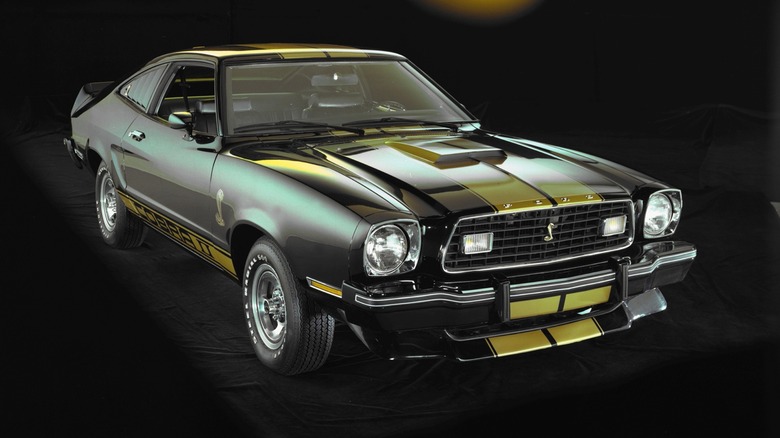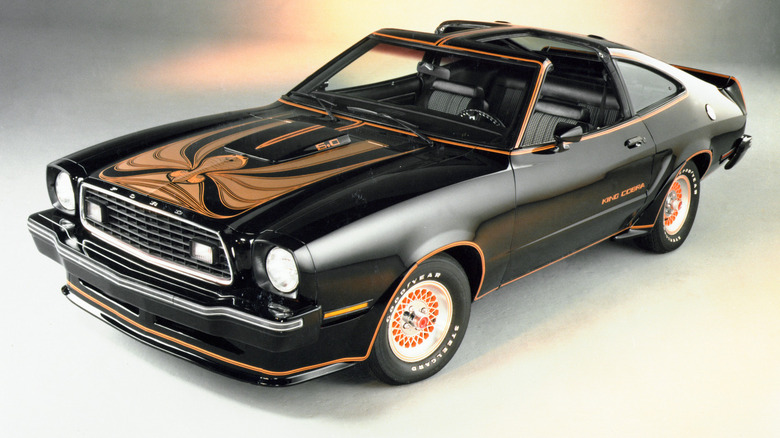Does The Worst Mustang Really Deserve Its Dire Reputation?
If there's any Ford Mustang generation nearly universally loathed by the enthusiast community, it's the Mustang II. It's easy to see why at a glance: These cars are often derided as being just reskinned Ford Pintos, due to their shared platform and various powertrain offerings. Opinions today remain as divisive as ever, with many articles, forum posts, and videos discussing all its well-known faults at length. True, the car was a stopgap due to the First Oil Crisis which kickstarted the Malaise Era, and featured the lowest power figures ever seen in a Mustang with just 88 horsepower from the base-model Lima inline-four. But was it actually that bad?
The reality of this vehicle's history is far more nuanced and cannot be taken in a vacuum. Ultimately, it's inexorably tied to the political climate of the era. However, it's also due to this reason that the Mustang II might actually be the most important Mustang in the lineage. It transitioned the Mustang from a large, inefficient muscle car into one that prioritized combining many elements: aerodynamics, fuel-efficiency, price-point, and sportiness.
The 1973 Mustang bordered on personal luxury car status with models like the Mustang Grande, which would've suffered heavily under the post-Oil Crisis restrictions. So, while the Mustang II certainly wasn't what most people expected to wear a Mustang badge, its sales figures told another story. Ultimately, it carried the Mustang name through the harshest timeframe to be a muscle car. In short, no, it doesn't deserve its sour reputation, and that's because of several factors. Let's dive in and discuss them in detail, starting with the hard facts and performance figures.
An economic mindset
The main source of hatred appears to center around the car's lackluster performance figures, and it's true that it wasn't fast. Originally, the Mustang II didn't even feature a V8, with Ford finally adding a 302 V8 as an option in 1975. That engine produced a mere 140 horsepower from 5 liters of displacement, meaning it still took over 10 seconds to hit 60 mph. It hardly improved by the latter years. In a Motor Trend test, the top-end King Cobra managed that speed in around nine seconds, the slowest top-tier Mustang of any generation.
Similarly, the handling didn't win any awards, either. Autoweek complained that the King Cobra was stiffly-sprung and offered poor ride quality, which is perhaps not too surprising given the car's relation with the Pinto. Meanwhile, other contemporary reviews described the typical base-model handling as flaccid, with excessive body lean even with the so-called competition suspension package. All that is to say, the Mustang II offers few redeeming qualities on the power or handling departments.
But, that was hardly the point of why Ford made the Mustang II. Where this car truly shone was with the fuel economy. A pre-Oil Crisis 1973 first-gen Mustang's gas mileage typically averages in the teens. By 1976, the all-new Mustang II saw over 30 MPG on the highway and 27 MPG combined with the Lima four-cylinder. This was a time when the cost of oil per barrel quadrupled almost overnight, ushering the rise of the Japanese compact with their small engines that merely sipped gas. The Malaise Era hit larger vehicles particularly heavily, so the Mustang's diminutive size and power worked in its favor.
Giving the people what they want
The outgoing Mustang saw a significant sales dip in its final model years, selling just 134,817 cars in model year 1973. By comparison, Ford sold over 600,000 Mustangs in 1966, its most popular year. Why was it so popular? For one, many compelling offerings from other brands drew interest, such as the Mopar E-body cars, GM F-bodies, and oddballs like the AMC Javelin. It wasn't actually that large, contrary to popular belief. In fact, its 109-inch wheelbase was just one inch longer than the original. But it added over a foot of bodywork and 700 pounds extra on packages like the luxury-oriented Mustang Grande. This gave the Mustang an overall bloated appearance over its previous model years.
Ultimately, however, the Oil Crisis was just around the corner, and customer sensibilities rapidly shifted. People wanted something small, sporty, and inexpensive, like the original. The Mustang needed a major overhaul, and fast, otherwise the nameplate might've disappeared entirely in the mid 1970s. As it turns out, the Mustang II was developed at exactly the right time.
Like the original mid-1960s Mustang, Car and Driver also thought the Mustang II was a compact, lightweight, family-friendly sporty machine, marketed towards a budget-conscious consumer. Perhaps too compact and underpowered for some today, but sales figures don't lie. With the Mustang's new direction, sales tripled overnight to almost 386,000 in its debut year, with a total of 1,107,718 sold from 1974 to 1978. That averages to over 200,000 a year, an unquestionably respectable number, and one which kept the Mustang nameplate in the black.


